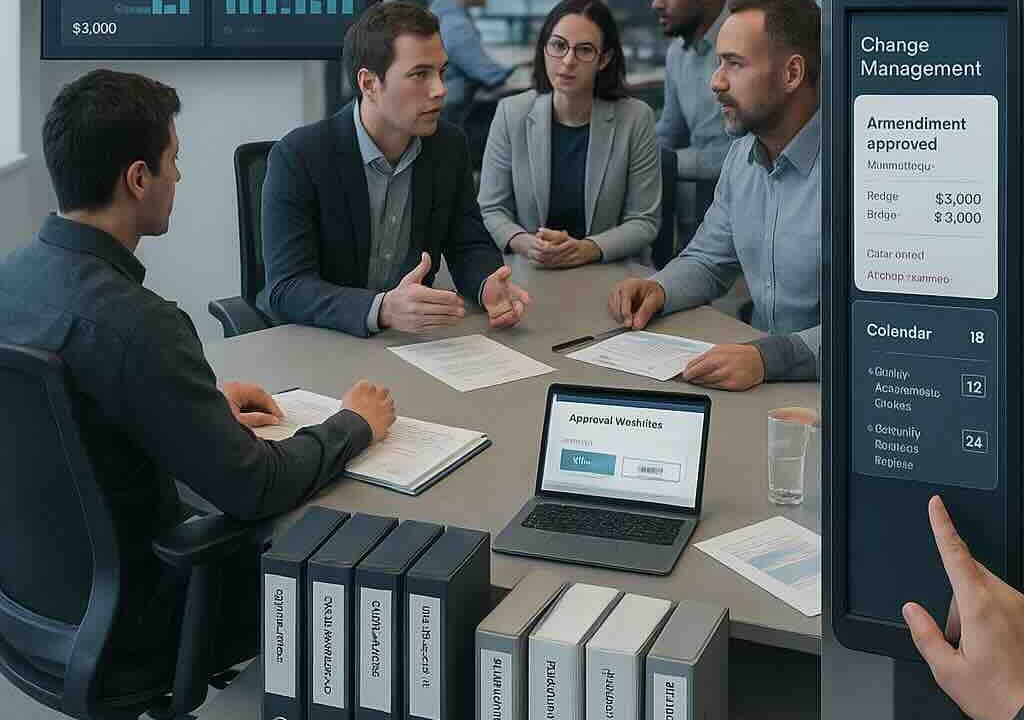Introduction
In Learn How to Source’s eight‑step framework, Step 8: Contract Management ensures that once a contract is in place, both parties deliver on their promises—and that any necessary changes are handled in a structured, cost‑controlled way. Tactical buyers play a key role monitoring supplier performance, measuring compliance via pre‑defined KPIs, and managing change requests to keep the engagement on track and within budget. Contract Management according to Wikipedia
This post is connected to the Learn How to Source course Sourcing Process 2b.
Content….
Case Narrative: ACME Electronics’ Ongoing Contract Management
After successfully implementing contracts with:
- Supplier Alpha – standardized electronic resistors
- Supplier Beta – custom microcontrollers
- Office Essentials Co. – reception supplies catalog
- HelpDeskNow – IT service desk
- BuildParts Ltd. – construction components
- NutBolt VMI – vendor‑managed inventory for nuts & bolts
ACME’s procurement team now transitions to contract management. They must track performance, enforce KPIs, handle inevitable changes, and control costs throughout the contract term.
Activities & Outputs
| Activity | Output |
|---|---|
| 1. KPI Definition & Dashboard Setup | Live dashboard showing performance against each KPI |
| 2. Regular Performance Reviews | Monthly (or other frequency) scorecards, remediation plans for any KPI shortfalls |
| 3. Change Request Management | Formal change‑order log; cost impact analysis; approved amendments |
| 4. Invoice & Cost Control | Three‑way match reports; variance reports against baseline cost |
| 5. Stakeholder Communications | Quarterly business reviews with stakeholders and suppliers |
Example KPIs by Contract Type
Components (Supplier Alpha & Beta)
- On‑Time Delivery (%): % of shipments received by the agreed delivery date
- Average Lead time (LT) : Average LT on orders delivered versus contracted LT
- Quality Yield (%): % of components passing first‑article inspection (if testing is recommended)
Office Material Services (Office Essentials Co.)
- Order Fulfillment Time (hrs): Average time from order submission to delivery at reception desk
- Stockout Rate (%): % of catalog items out‑of‑stock at point of order
- Catalog Accuracy (%): % of ERP catalog entries matching actual product specs
IT Helpdesk (HelpDeskNow)
- First Response Time (mins): Average time to respond to a new ticket
- Resolution Rate (%): % of tickets resolved within SLA (e.g., 4 hrs for priority tickets)
- User Satisfaction Score: Average rating from post‑ticket survey
Construction Parts (BuildParts Ltd.)
- On‑Site Delivery %: % of deliveries arriving on‑site by the scheduled time window
- Damage Rate (%): % of parts delivered damaged
- Correct Documentation (%): % of shipments including complete compliance paperwork
VMI Nuts & Bolts (NutBolt VMI)
- Inventory Turnover (×/month): Frequency with which the VMI stock is refilled
- Stock Availability (%): % of time the VMI bin remains above the reorder threshold
- Bin Accuracy (%): Amount of parts in bin vs. system‑recorded quantity
Change Management & Cost Control
Change Management Process:
- Change Request Submission: Any stakeholder (e.g., engineering, operations) submits a documented request (scope, rationale).
- Impact Assessment: Procurement and Finance (Controller) jointly analyze cost, schedule, and KPI impacts.
- Supplier Negotiation: Agree on revised pricing, delivery, or service terms. Document in a contract amendment.
- Approval & Communication: Obtain internal approvals, update dashboards, and notify affected teams.
- Implementation & Monitoring: Track the change’s execution, adjust KPIs if needed, and control resulting costs.
Cost Control Techniques:
- Baseline Comparison: Regularly compare actual spend to original contract value and any approved change‑order budgets.
- Three‑Way Match: Validate invoices against delivered quantities and approved changes.
- Variance Reporting: Highlight over‑ or under‑utilization of change budgets, triggering corrective action.
- Escalation Protocol: Automatic alerts when change costs exceed thresholds (e.g., 10 % of original contract value).
Learning Points & Reflection
- KPI Effectiveness: Which KPIs are most critical for your contract types, and how would you visualize them?
- Governance: How would you structure your change‑management board to balance agility with cost control?
- Communication: What cadence and channels ensure stakeholders remain informed of performance and changes?
- Continuous Improvement: How can contract data (KPI trends, change‑order histories) feed back into your next sourcing cycle?
Final Reflection Question:
In your original schedule (Step 1), how did you allocate time and resources for contract management activities? How does the complexity of your contracts (simple catalogue updates vs. multi‑phase PPQ or VMI) alter that plan?
Illustration to the post “Step 8 Case Study: Contract Management” was created by SORA on April 20, 2025.
